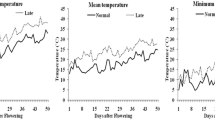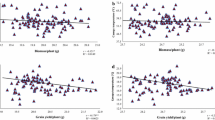Abstract
Increasing temperature is likely to affect productivity of wheat and chickpea crop. A field experiment was conducted for two consecutive years with wheat and chickpea crop raised inside the temperature gradient tunnel (TGT). Results showed that high temperature reduced crop growth duration in both the crops. Days to 50 % flowering reduced by 4–5 days in wheat with 1.8–2.9 °C increase in temperature. Photosynthesis rate, stomatal conductance and leaf area index reduced with the rise in temperature. High temperature inside the TGT caused reduction in both biomass and grain yield of wheat crop in both the years and the reductions in yield per degree temperature rise was 10.4–10.5 % in wheat crop. Number of spikes per plant, number of grains per spike, 1,000 seed weight was also affected with increased temperature. In case of chickpea crop, yield declined with the increase in temperature during the 2008–2009 year and the decline per degree temperature rise was 6.8 %. During the year 2007–2008, 1.7 °C increase in temperature showed improvement in biomass and grain yield in chickpea. Low air temperature during the crop growth period in 2007–2008 could be responsible for increased growth of chickpea under high temperature. This suggests that rise in temperature in future climatic change scenario will adversely affect wheat and chickpea crop but the response will be crop and region specific depending upon the existing climate conditions.




Similar content being viewed by others

References
Aggarwal, P. K. (2007). Climate change: Implication for Indian Agriculture. Jalvigyan Sameeksha, 22, 37–46.
Aggarwal, P. K., & Mall, R. K. (2002). Climate change and rice yields in diverse agro-environments of India. II. Effect of uncertainties in scenarios and crop models on impact assessment. Climate Change, 52, 331–343.
Altenbach, S. B., DuPont, F. M., Kothari, K. M., Chan, R., Johnson, E. L., & Lieu, D. (2003). Temperature, water and fertilizer influence the timing of key events during grain development in a US spring wheat. Journal of Cereal Science, 37, 9–20.
Angadi, S. V., Cutforth, H. W., Miller, P. R., McConkey, B. G., Entz, M. H., Volkmar, K., et al. (2000). Response of three Brassica species to high temperature injury during reproductive growth. Canadian Journal of Plant Science, 80, 693–701.
Bunce, J. A. (2000). Response of stomatal conductance to light, humidity and temperature in winter wheat and barley grown at three concentrations of carbon dioxide in the field. Global Change Biology, 6, 371–382.
Centritto, M., & Loreto, F. (2005). Photosynthesis in a changing world: Photosynthesis and abiotic stresses. Agriculture, Ecosystems & Environment, 106, 115–117.
Challinor, A. J., & Wheeler, T. R. (2008). Crop yield reduction in the tropics under climate change: Processes and uncertainties. Agricultural and Forest Meteorology, 148, 343–356.
Davies, S. L., Turner, N. C., Siddique, K. H. M., Plummer, J. A., & Leport, L. (1999). Seed growth of desi and kabuli chickpea (Cicer arietinum L.) in a short-season Mediterranean-type environment. Australian Journal of Experimental Agriculture, 39, 181–188.
Entz, M. H., & Fowler, D. B. (1991). Agronomic performance of winter versus spring wheat. Agronomy Journal, 83, 527–532.
Ferris, R., Wheeler, T. R., Hadley, P., & Ellis, R. H. (1998). Recovery of photosynthesis after environmental stress in soybean grown under elevated CO2. Crop Science, 38, 948–955.
IPCC. (2007). The synthesis report of the Intergovernmental Panel on climate change. Cambridge: Cambridge University Press.
Khetrapal, S., Pal, M., & Lata, S. (2009). Effect of elevated temperature on growth and physiological characteristics in chickpea cultivars. Indian Journal of Plant Physiology, 14(4), 377–383.
Khushwaha, S. R., Deshmukh, P. S., Sairam, R. K., & Singh, M. K. (2011). Effect of high temperature stress on growth, biomass and yield of wheat genotypes. Indian Journal of Plant Physiology, 16(1), 93–97.
Koecheki, A., Nassiri, M., Soltani, A., Sharifi, H., & Ghorbani, R. (2006). Effects of climate change on growth criteria and yield of sunflower and chickpea crops in Iran. Climate Research, 30, 247–253.
Laurie, S., & Stewart, G. R. (1993). Effects of nitrogen supply and high temperature on the growth and physiology of the chickpea. Plant, Cell and Environment, 16(6), 609–621.
Leport, L., Turner, N. C., Davies, S. L., & Siddique, K. H. M. (2006). Variation in pod production and abortion among chickpea cultivars under terminal drought. European Journal of Agronomy, 24, 236–246.
Leport, L., Turner, N. C., French, R. J., Barr, M. D., Duda, R., Davies, S. L., et al. (1999). Physiological responses of chickpea genotypes to terminal drought in a Mediterranean-type environment. European Journal of Agronomy, 11, 279–291.
Liu, P. H., Gan, Y. T., Warkentin, T., & McDonald, C. L. (2003). Morphological plasticity of chickpea in a semiarid environment. Crop Science, 43, 426–429.
Morison, J. I. L., & Lawlor, D. W. (1999). Interactions between increasing CO2 concentration and temperature on plant growth. Plant, Cell & Environment, 22, 659–682.
Nicolas, M. E., Gleadow, R. M., & Dalling, M. J. (1984). Effects of drought and high temperature on grain growth in wheat. Australian Journal of Plant Physiology, 11, 553–566.
Panse, V. G., & Sukhatme, P. V. (1967). Statistical methods for agricultural workers. New Delhi: ICAR Publication.
Paulsen, G. M. (1994). High temperature responses of crop plants. In K. J. Boote, et al. (Eds.), Physiology and determination of crop yield. Madison: ASA, CSSA, SSSA.
Sadras, V. O., & Monzon, J. P. (2006). Modelled wheat phenology captures rising temperature trends: Shortened time to flowering and maturity in Australia and Argentina. Field Crops Research, 99, 136–146.
Savin, R., & Nicolas, M. E. (1996). Effects of short periods of drought and high temperature on grain growth and starch accumulation of two malting barley cultivars. Australian Journal of Plant Physiology, 23, 201–210.
Schapendonk, A. H. C. M., Xu, H. Y., Van Der Putten, P. E. L., & Spiertz, J. H. J. (2007). Heat-shock effects on photosynthesis and sink-source dynamics in wheat (Triticum aestivum L.). NJAS—Wageningen Journal of Life Sciences, 55, 37–54.
Shah, N. H., & Paulsen, G. M. (2003). Interaction of drought and high temperature on photosynthesis and grain filling of wheat. Plant and Soil, 257, 219–226.
Tao, F., Yokozawa, M., Xu, Y., Hayashi, Y., & Zhang, Z. (2006). Climate changes and trends in phenology and yields of field crops in China from 1981–2000. Agricultural and Forest Meteorology, 138, 82–92.
Wang, J., Gan, Y. T., Clarke, F., & McDonald, C. L. (2006). Response of chickpea to high temperature stress during reproductive development. Crop Science, 46, 2171–2178.
Zacharias, M., Singh, S. D., Kumar, S. N., Harit, R. C., & Aggarwal, P. K. (2010). Impact of elevated temperature at different phonological stages on the growth and yield of wheat and rice. Indian Journal of Plant Physiology, 15(4), 350–358.
Acknowledgments
The generous funding from the Network Project on climate change of the Indian Council of Agricultural Research supported this work.
Author information
Authors and Affiliations
Corresponding author
Rights and permissions
About this article
Cite this article
Chakrabarti, B., Singh, S.D., Kumar, V. et al. Growth and yield response of wheat and chickpea crops under high temperature. Ind J Plant Physiol. 18, 7–14 (2013). https://doi.org/10.1007/s40502-013-0002-6
Received:
Accepted:
Published:
Issue Date:
DOI: https://doi.org/10.1007/s40502-013-0002-6



